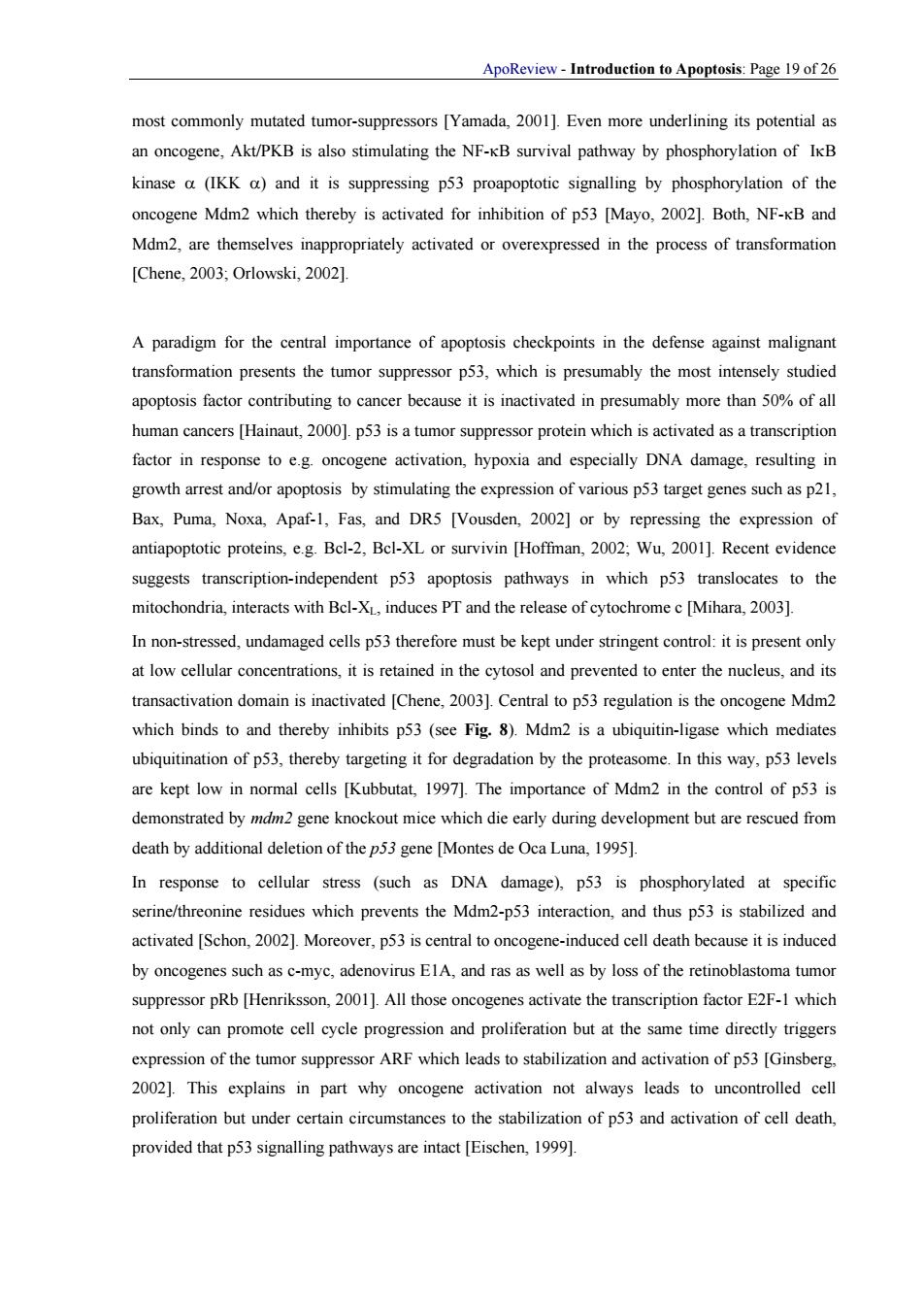正在加载图片...

ApoReview-Introduction to Apoptosis:Page 19of 26 most commonly mutated tumor-suppressors [Yamada,2001].Even more underlining its potential as an oncogene,Akt/PKB is also stimulating the NF-KB survival pathway by phosphorylation of IkB kinase a(IKK a)and it is suppressing p53 proapoptotic signalling by phosphorylation of the oncogene Mdm2 which thereby is activated for inhibition of p53 [Mayo,2002]Both.NF-B and Mdm2,are themselves inappropriately activated or overexpressed in the process of transformation [Chene,2003:Orlowski,2002] A paradigm for the central importance of apoptosis checkpoints in the defense against malignant transformation presents the tumor suppressor p53,which is presumably the most intensely studied apoptosis factor contributing to cancer because it is inactivated in presumably more than 50%of all human cancers [Hainaut,2000].p53 is a tumor suppressor protein which is activated as a transcription factor in response tog.oncogene activation,hypoxia and especially DNA damage.resulting in growth arrest and/or apoptosis by stimulating the expression of various p53 target genes such as p21. Bax,Puma,Noxa,Apaf-1,Fas,and DR5 [Vousden,2002]or by repressing the expression of antiapoptotic proteins,.g.Bel-2.Bcl-XLor survivin [Hoffman,02.Wu,001].Recent evidence suggests transcription-independent p53 apoptosis pathways in which p53 translocates to the mitochondria,interacts with Bel-X induces PT and the release of cytochrome c [Mihara,2003]. In non-stressed,undamaged cells p53 therefore must be kept under stringent control:it is present only at itis retained in the ytosol and prevented its transactivation domain is inactivated [Chene.20031.Central to p53 regulation is the oncogene Mdm2 which binds to and thereby inhibits p53 (see Fig.8).Mdm2 is a ubiquitin-ligase which mediates ubiquitination of p53.thereby targeting it for degradation by the proteasome In this way,p53 levels are kept low in normal cells [Kubbutat.1997].The importance of Mdm2 in the control of p53 is demonstrated by mdm2 gene knockout mice which die early during development but are rescued from death by additional deletion of the p5gene [Montes de Oca Luna,1995] In response to cellular stress (such as DNA damage).p53 is phosphorylated at specific serine/threonine residues which prevents the Mdm2-p53 interaction,and thus p53 is stabilized and activated [Schon,2002].Moreover,p53 is central to oncogene-induced cell death because it is induced by oncogenes such as c-myc,adenovirus EIA,and ras as well as by loss of the retinoblastoma tumor suppressor pRb [Henriksson,2001].All those oncogenes activate the transcription factor E2F-1 which not only can promote cell cycle progression and proliferation but at the same time directly triggers expression of the tumor suppressor ARF which leads to stabilization and activation of p53 [Ginsberg. 2002].This explains in part why oncogene activation not always leads to uncontrolled cell proliferation but under certain circumstances to the stabilization of p53 and activation of cell death, provided that p53 signalling pathways are intact [Eischen,1999ApoReview - Introduction to Apoptosis: Page 19 of 26 most commonly mutated tumor-suppressors [Yamada, 2001]. Even more underlining its potential as an oncogene, Akt/PKB is also stimulating the NF-κB survival pathway by phosphorylation of IκB kinase α (IKK α) and it is suppressing p53 proapoptotic signalling by phosphorylation of the oncogene Mdm2 which thereby is activated for inhibition of p53 [Mayo, 2002]. Both, NF-κB and Mdm2, are themselves inappropriately activated or overexpressed in the process of transformation [Chene, 2003; Orlowski, 2002]. A paradigm for the central importance of apoptosis checkpoints in the defense against malignant transformation presents the tumor suppressor p53, which is presumably the most intensely studied apoptosis factor contributing to cancer because it is inactivated in presumably more than 50% of all human cancers [Hainaut, 2000]. p53 is a tumor suppressor protein which is activated as a transcription factor in response to e.g. oncogene activation, hypoxia and especially DNA damage, resulting in growth arrest and/or apoptosis by stimulating the expression of various p53 target genes such as p21, Bax, Puma, Noxa, Apaf-1, Fas, and DR5 [Vousden, 2002] or by repressing the expression of antiapoptotic proteins, e.g. Bcl-2, Bcl-XL or survivin [Hoffman, 2002; Wu, 2001]. Recent evidence suggests transcription-independent p53 apoptosis pathways in which p53 translocates to the mitochondria, interacts with Bcl-XL, induces PT and the release of cytochrome c [Mihara, 2003]. In non-stressed, undamaged cells p53 therefore must be kept under stringent control: it is present only at low cellular concentrations, it is retained in the cytosol and prevented to enter the nucleus, and its transactivation domain is inactivated [Chene, 2003]. Central to p53 regulation is the oncogene Mdm2 which binds to and thereby inhibits p53 (see Fig. 8). Mdm2 is a ubiquitin-ligase which mediates ubiquitination of p53, thereby targeting it for degradation by the proteasome. In this way, p53 levels are kept low in normal cells [Kubbutat, 1997]. The importance of Mdm2 in the control of p53 is demonstrated by mdm2 gene knockout mice which die early during development but are rescued from death by additional deletion of the p53 gene [Montes de Oca Luna, 1995]. In response to cellular stress (such as DNA damage), p53 is phosphorylated at specific serine/threonine residues which prevents the Mdm2-p53 interaction, and thus p53 is stabilized and activated [Schon, 2002]. Moreover, p53 is central to oncogene-induced cell death because it is induced by oncogenes such as c-myc, adenovirus E1A, and ras as well as by loss of the retinoblastoma tumor suppressor pRb [Henriksson, 2001]. All those oncogenes activate the transcription factor E2F-1 which not only can promote cell cycle progression and proliferation but at the same time directly triggers expression of the tumor suppressor ARF which leads to stabilization and activation of p53 [Ginsberg, 2002]. This explains in part why oncogene activation not always leads to uncontrolled cell proliferation but under certain circumstances to the stabilization of p53 and activation of cell death, provided that p53 signalling pathways are intact [Eischen, 1999]